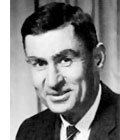Nationality RussianAmerican Fields Political Economy Role Economist | Name Evsey Domar | |
 | ||
Alma mater University of California, Los AngelesUniversity of MichiganHarvard University Books Essays in the Theory of Economic Growth, Capitalism, Socialism, and Serfdom: Essays by Evsey D. Domar Influenced by John Maynard Keynes, John A. Hobson Similar People John Maynard Keynes, Robert Fogel, Sir John Richard Hicks, Douglass North, Simon Kuznets | ||
Evsey David Domar (Russian: Евсей Давидович Домашевицкий, Domashevitsky; April 16, 1914 – April 1, 1997) was a Russian American economist, famous as co-author of the Harrod–Domar model.
Contents
Life
Evsey Domar was born on April 16, 1914 in the Polish city of Łódź, which was part of Russia at that time. He was raised and educated in Russian Outer Manchuria, then emigrated to the United States in 1936.
He received a Bachelor of Arts from UCLA in 1939, a Master of Science from the University of Michigan in 1940, a Master of Science from Harvard University in 1943, and a doctorate from Harvard in 1947.
In 1946 Evsey Domar married Carola Rosenthal. The couple had two daughters.
He was a professor at the Carnegie Institute of Technology, The University of Chicago, the Johns Hopkins University and then at the Massachusetts Institute of Technology from 1957 until the end of his career.
Evsey Domar was president of the Association for Comparative Economics and a member of several other academic organizations including the American Academy of Arts and Sciences, the Econometric Society, and the Center for Advanced Study in the Behavioral Sciences. He was on the executive committee of the American Economic Association from 1962 until 1965, and became the organization's vice president in 1970.
He worked for the RAND Corporation, the Ford Foundation, the Brookings Institution, the National Science Foundation, the Battelle Memorial Institute, and the Institute for Defense Analysis.
Evsey Domar died on April 1, 1997 in the Emerson Hospital in Concord, Massachusetts.
Work
Evsey Domar was a Keynesian economist. He has made contributions in three main areas of economics: economic history, comparative economics and economic growth. In 1946 he advanced the idea that economic growth served to lighten the deficit and the national debt. During the Cold War he was also an expert on Soviet economics.
He is most known for developing, independently of British economist Roy Forbes Harrod, what has become to be known as the Harrod–Domar model of economic growth. This model was the precursor to the neoclassical model of economic growth, differing mainly in its restrictive assumption that the Leontief production function applied, which meant there would be fixed proportions of capital and labor in production, not substitution between them. In the model, economic growth was unstable. The Solow–Swan model that followed several years later borrowed heavily from the Harrod-Domar model and used a variable proportions Cobb–Douglas production function.
Domar's 1961 paper is cited as the source of Domar aggregation, a set of rules and processes for combining industry growth data together to get aggregate industry sector or national growth.
Among his students was the economic historian Robert Fogel, who was awarded the Nobel Memorial Prize in Economics in 1993.
